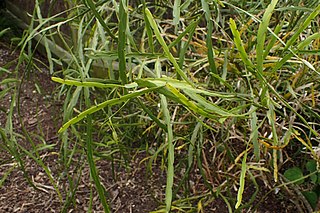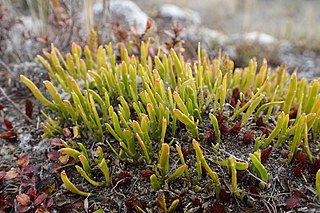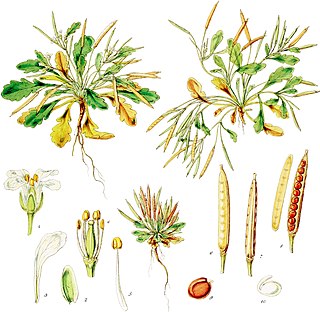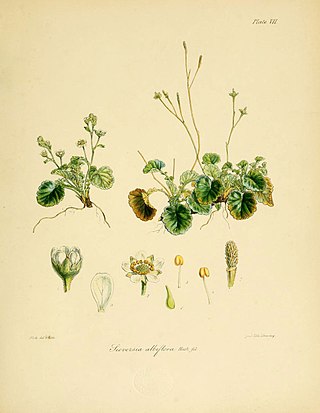
Pleurophyllum speciosum, also known as the giant emperor daisy or Campbell Island daisy, is a megaherb native to the Auckland and Campbell Islands of New Zealand. A false colour image is depicted on the lower left corner on the reverse of the current five dollar New Zealand banknote. The Campbell Island daisy was first described by Joseph Dalton Hooker in Flora Antarctica of 1844, after he had collected it during the Ross expedition.

Poa foliosa is a species of tussock grass commonly known as muttonbird poa. It is native to the subantarctic islands of New Zealand and Australia.

Leptinella plumosa is a small flowering plant in the daisy family. It is a circumantarctic species found on many subantarctic islands in the Southern Ocean. The specific epithet comes from the Latin for “feathery”, referring to the form of the leaves.

Dracophyllum longifolium, commonly called inaka, is an upright shrub or small tree in the family Ericaceae that is endemic to New Zealand.

Deschampsia chapmanii is a plant species in the grass (Poaceae) family, native to New Zealand and Macquarie Island.

Chionochloa antarctica is a species of grass, endemic to the Auckland and Campbell Islands.

Anthoxanthum brunonis is a species of grass, native to the South Island of New Zealand and to the Auckland and Campbell Islands.

Leptinella filiformis, or slender button daisy, is a species of flowering plant in the daisy family, found only in the north-eastern part of the South Island of New Zealand. Thought to be extinct by the 1980s, it was rediscovered growing on a Hanmer Springs hotel lawn in 1998, and in the wild in 2015.

Carmichaelia astonii is a species of pea in the family Fabaceae. It is found only in South Island of New Zealand. Its conservation status (2018) is "Nationally vulnerable" under the New Zealand Threat Classification System.

Carmichaelia appressa is a species of pea in the family Fabaceae. It is found only in the South Island of New Zealand. Its conservation status (2018) is "At Risk - Naturally Uncommon" under the New Zealand Threat Classification System.

Carmichaelia australis, or common broom, is a species of pea in the family Fabaceae. It is native to New Zealand and found in both the North and South Islands. Its conservation status (2018) is "Not Threatened" under the New Zealand Threat Classification System.

Carmichaelia williamsii is a species of plant in the family Fabaceae. It is found only in the North Island of New Zealand. Its conservation status (2018) is "At Risk (relict)" under the New Zealand Threat Classification System.

Carmichaelia nana is a species of plant in the family Fabaceae. It is found in both the North and South Islands of New Zealand. Its conservation status in 2013 was assessed as "At Risk (declinining)" under the New Zealand Threat Classification System, but in 2018 its risk under the same system became "Threatened-Nationally Vulnerable".

Azorella schizeilema is a species of cushion plant in the Apiaceae family, native to the Auckland and Campbell Islands.

Isolepis aucklandica is a species of flowering plant in the Cyperaceae family. It is native to New Zealand, Australia, Argentina, Peru, Colombia, Ecuador, Macquarie Island, the French Southern Territories of Saint Paul and Amsterdam Islands, and New Guinea.

Carex erebus is a member of the sedge family and is found on the Antarctic Islands of Australia and New Zealand.

Agrostis subulata is a grass, which grows only on Campbell Island and on Antipodes Island in New Zealand.

Cardamine depressa is a plant in the Brassicaceae family, found in the Antipodean Islands.

Geum albiflorum is a plant in the rose family, Rosaceae family, found in the Auckland Islands.

Actinotus novae-zelandiae is a plant in the Apiaceae family, native to the South Island of New Zealand.





















